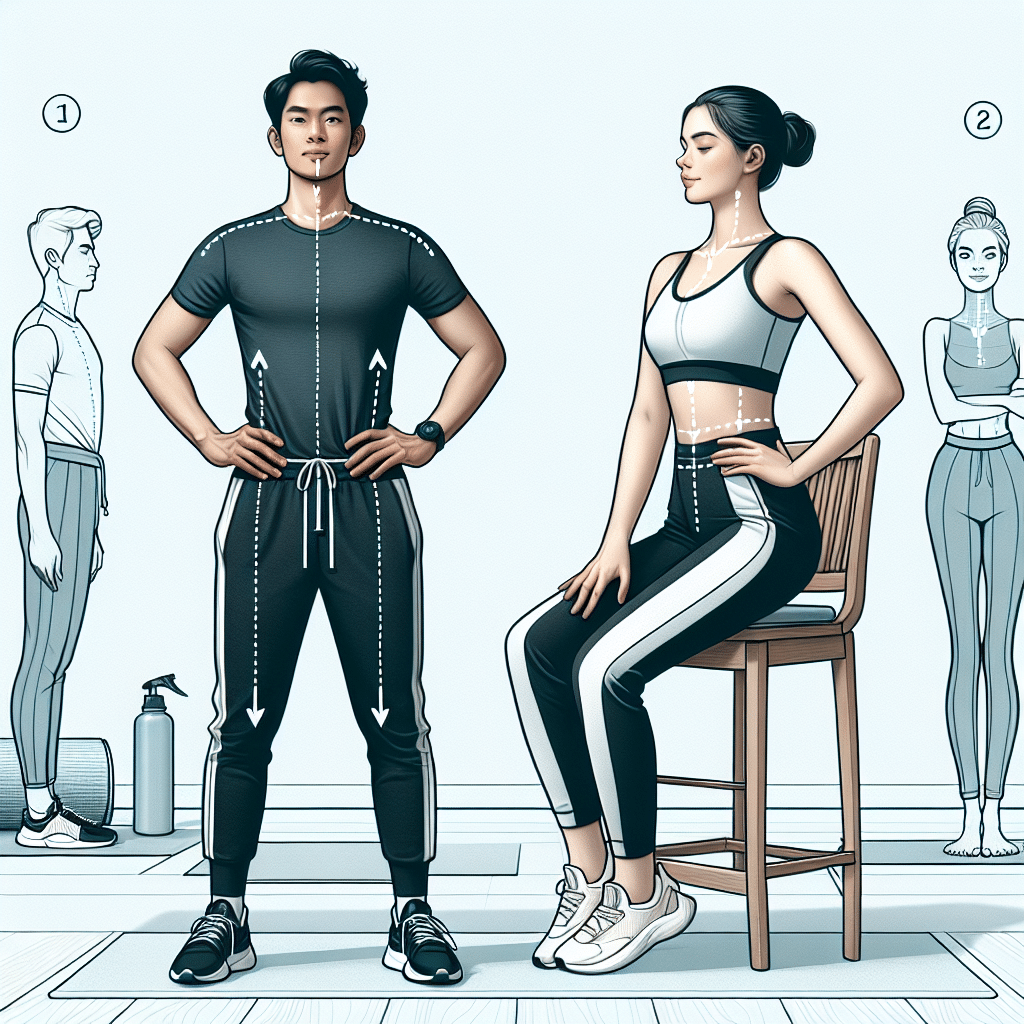Understanding Posture Correction
Good posture is vital for overall health, impacting the spine, muscles, and even internal organs. Poor posture can lead to back pain, decreased lung capacity, and other health issues. For beginners, understanding basic posture mechanics helps prevent injury while establishing effective routines.
Recognizing Poor Posture
Before beginning a correction routine, it’s essential to identify poor posture types:
- Forward Head Posture: The head leans forward, straining neck muscles.
- Rounded Shoulders: Shoulders roll forward, leading to tight chest muscles and weak upper back.
- Excessive Lumbar Curve (Lordosis): An exaggerated curve in the lower back can lead to discomfort.
- Flat Back: Reduced spinal curvature, making it harder to maintain balance and mobility.
Importance of Muscle Imbalance Awareness
Muscle imbalances often accompany poor posture. This includes tight muscles on one side and weak ones on the other, significantly affecting posture. Recognizing these patterns can help tailor correction routines.
Posture Correction Routines
Daily Warm-up Routine
1. Neck Stretch
- Sit or stand comfortably.
- Gently tilt your head to each side, holding each position for 15-20 seconds.
- Repeat 2-4 times.
2. Chin Tucks
- Sit up straight and draw your chin towards your neck without tilting the head.
- Hold for 5 seconds, then release.
- Repeat 10 times.
3. Shoulder Rolls
- Firmly place your hands on your hips.
- Roll your shoulders up, back, and down in a circular motion.
- Perform 10 rolls backward and 10 forward.
4. Wall Angels
- Stand against a wall with your feet 6 inches away.
- Keep your lower back, upper back, and head touching the wall.
- Extend your arms out to form a “W,” then slide them up to form a “Y.”
- Repeat 10 times.
Core Strengthening Routine
1. Planks
- Assume a push-up position, keeping elbows directly under shoulders.
- Maintain a straight line from head to heels.
- Hold for 20-30 seconds, building up to a minute with practice.
2. Dead Bugs
- Lie on your back with arms extended upwards and knees bent at 90 degrees.
- Slowly lower your right arm and left leg towards the floor while maintaining core engagement.
- Return to the start position and switch sides.
- Repeat 10 times per side.
3. Bird Dogs
- Start on all fours with wrists under shoulders and knees under hips.
- Extend your right arm and left leg, maintaining a straight line from fingertips to toes.
- Hold for a few seconds before switching sides.
- Perform 10 repetitions on each side.
Flexibility and Mobility Routine
1. Cat-Cow Stretch
- Start on all fours.
- Arch your back upward (Cat) and then lower it while raising your head and tailbone (Cow).
- Repeat for 10-15 cycles.
2. Chest Stretch
- Stand tall and clasp hands behind your back, straightening your arms.
- Lift your arms while opening your chest.
- Hold for 20-30 seconds.
3. Hip Flexor Stretch
- Kneel on the ground and place one foot in front to create a lunge position.
- Push your hips forward to stretch the hip flexors.
- Hold for 20-30 seconds on each side.
Incorporating Mindfulness
Practicing mindfulness can significantly enhance posture correction efforts. Being aware of body positioning throughout daily activities can foster better habits.
- Breathing Techniques: Focusing on diaphragmatic breathing can help engage core muscles and encourage proper posture.
- Mindful Sitting: During work hours, consciously adjust your position to ensure your back is straight and feet are flat on the ground.
Tips for Maintaining Good Posture
- Ergonomic Workspace: Adjust your desk, chair, and computer height to promote a natural posture.
- Frequent Breaks: Stand up and stretch every 30 minutes to counteract prolonged sitting.
- Posture Reminders: Use apps or set timers to prompt posture checks throughout your day.
Tracking Progress
Keep a journal or use smartphone apps to track your posture improvement. Documenting your routines, feelings, and any physical changes can help stay motivated.
Recommended Tools
- Posture Correctors: These devices can aid in developing awareness of bad posture.
- Exercise Bands: Excellent for strengthening exercises, these are portable and versatile tools for beginners.
- Foam Rollers: Beneficial for releasing muscle tension and enhancing flexibility.
Addressing Common Challenges
- Lack of Time: Integrate short 5-10 minute routines into your daily activities.
- Discomfort: Start slowly and listen to your body to prevent injuries.
- Consistency: Establish a routine that fits seamlessly into your lifestyle.
Consultation with Professionals
Before starting any new exercise or routine, especially if you have pre-existing conditions or severe posture issues, consult a healthcare professional or a physical therapist to tailor a program suited to your individual needs.
Conclusion
Posture correction is a journey rather than a destination. By consistently incorporating tailored routines, promoting mindful habits, and utilizing available tools, beginners can improve their posture effectively, leading to better overall health and well-being.
